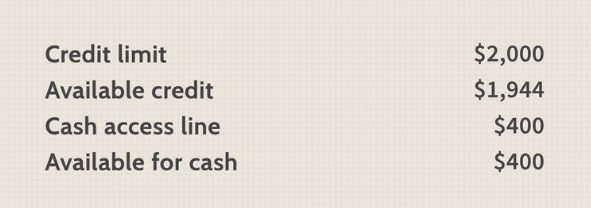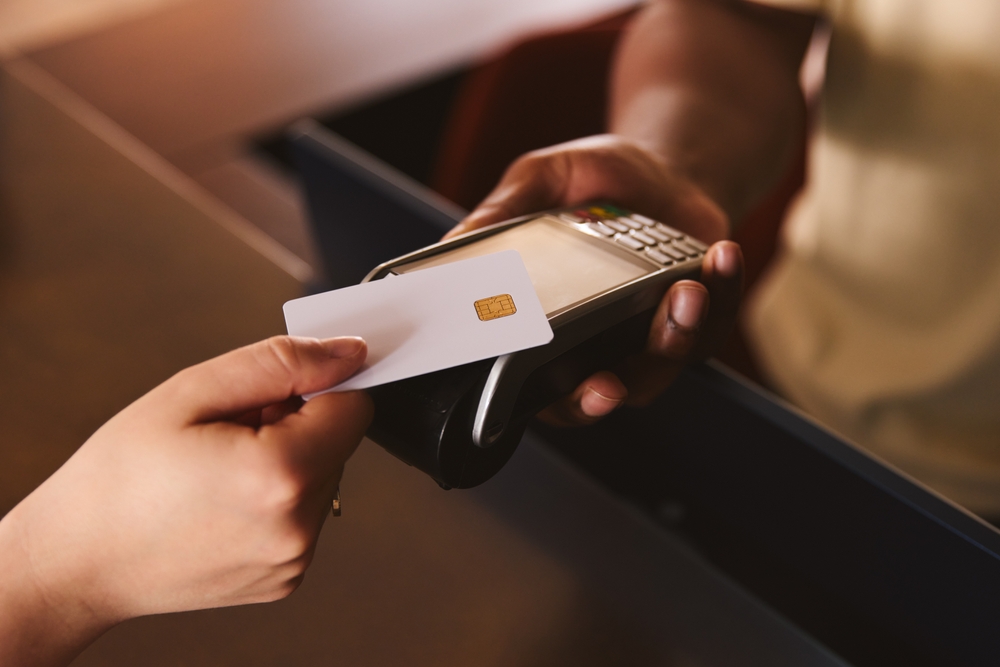Introduction
Credit cards have become an indispensable financial tool in today's digital world. According to a report from Transunion, credit card users reached 166 million at the end of 2022, showcasing the rising popularity of credit card usage.
Most credit cards come with a cash limit, the maximum amount you can withdraw against your total credit limit. This blog will cover everything you need about credit card cash limits.
Understanding Credit Card Cash Limits
A cash limit, sometimes called a cash advance limit, refers to the maximum dollar amount a credit card allows you to withdraw from ATMs or banks as cash. For example, your overall limit could be $5,000, with a $1,000 cash limit.
Cash limits differ from regular credit limits in that they are explicitly earmarked for cash withdrawals. Factors determining your initial cash limit include your credit score, income, existing limits, and the card issuer's policies.

Source: Investopedia
Manage your finances with confidence. Get the Bright Money App today!
How to Find Your Credit Card's Cash Limit
It is essential to know precisely your credit card's current cash limit. There are a few easy ways to identify and monitor your current cash limit:
- Carefully review your monthly credit card statement. Issuers are required to differentiate between regular purchase transactions and cash advances or withdrawals. Your statement will specify cash limit usage separately.
- Log into your credit card account via the issuer's website or mobile app. Most online banking portals prominently display your total credit limit, remaining available limit, and cash limit breakdowns. This provides real-time visibility.
- Contact your credit card issuer directly by phone, chat, or secure message. Speaking with a customer service representative allows you to ask for your current cash withdrawal limit and any pending changes.
- Read the full cardholder agreement provided upon opening the account. Issuers must disclose separate defined limits for overall credit and cash advances.
Checking your cash limit regularly instead of guessing ensures you know your standing. Unexpected emergencies transpire where immediate cash is needed, so monitoring this limit enables smart, informed use of the cash advance capability when required.
Reasons to Use Your Credit Card's Cash Limit
Your credit card's preset cash withdrawal limit can provide advantages over other means of accessing cash in certain situations. Potential benefits of using your card's cash limit include:
- Withdrawing cash for an emergency expense between pay cycles, such as an urgent car repair or unexpected medical bill that requires immediate funds. The cash limit offers a contingency source of money in a pinch.
- When traveling abroad, where ATM access may be scarce, the ability to withdraw cash directly from banks using your card's limit can prove useful. It can help avoid foreign transaction fees from third-party ATMs.
- Avoid the high interest rates and fees for a standard credit card cash advances and payday loans. Cash limits may carry lower costs, but compare the terms specified first.
- Accessing funds without the wait or credit checks of personal loans or other alternatives. The cash limit provides instant liquidity.
As long as it is used judiciously and sparingly, tapping your credit card's preset cash limit in certain circumstances can provide an extra buffer of funds to cope with important unplanned costs.
Cash Advances vs. Cash Limit
While they may sound similar, there are some notable distinctions between credit card cash advances and cash limits that consumers should recognize:
- Cash advances represent new debt borrowed against future card payments, often at exceptionally high interest rates. Cash limits utilize your existing available credit.
- Standard cash advances tack on fees immediately, sometimes around 5% of the amount advanced. Cash limits are treated as regular purchases without additional fees.
- Cash advance Annual Percentage Rates (APRs) do not fluctuate with promotional purchase rates. The image below demonstrates that the cash advance is 20% of the approved credit limit.

Source: Investopedia
When urgent access to cash is needed, tapping your card's preset cash limit is preferential over a traditional cash advance. When used prudently, the lower rates and fees can make a meaningful difference in long-term interest costs.
Monitoring Your Remaining Cash Limit
Staying on top of your credit card's remaining cash limit is prudent financial practice. Ways to consistently track your standing include:
- Carefully review monthly statements when they arrive to identify any new cash withdrawals or advances posted. Statements itemize these transactions.
- Enable account alerts and notifications that warn when you are nearing your overall credit limit or cash limit threshold. This prevents you from going above the limit.
- You should factor outstanding cash advances and withdrawals into your remaining limit, as that money is no longer available to borrow against.
- Regularly check your real-time cash limit through the card issuer's website or app. This provides up-to-date visibility.
Monitoring your cash limit situation helps prevent fees, credit score damage, or account suspension risks by avoiding exceeding your defined withdrawal limit.
Read more: Personal Finance Essentials and Credit Card Management
Tips for Responsible Use
When using your credit card's cash limit, be sure to do so prudently:
- Proactively budget for cash withdrawal repayments just as you would any other expense. Avoid ballooning balances by treating it as serious debt, not free money.
- Have a clear repayment plan to pay off cash advances before interest accrues. Refrain from overly relying on the cash limit as everyday spending.
- Only use the cash limit as an absolute last resort, not for discretionary purchases. First, consider safer options like drawing from savings that avoid borrowing.
- Monitor your overall credit utilization rate, as high balances can negatively impact your credit score. Keep utilization below 30% through timely payments.
With careful budgeting, risk analysis, and restraint, a credit card's cash limit can serve as an occasional safety net for true emergencies. However, responsible habits are crucial to avoid building up unmanageable debt.
What Happens if You Exceed Your Cash Limit?
Exceeding your credit card's defined cash limit can potentially trigger consequences, including:
- Over-limit fees of typically $25 to $35 can be charged. You must review your card's policy. Review your terms to understand fee exposure.
- Increased APRs as some issuers will spike interest rates after a cash limit violation as punishment. This can raise costs on all balances.
- Potential damage to your credit score stemming from high utilization and reported over-limit activity. Both factors elevate credit risk profiles.
- Possible account suspensions or cancellation for repeated excessive breaches of the cash limit, as this signals high default risk.
To avoid problems, stay prudent and maintain a sufficient buffer below your cash limit. To demonstrate good faith, contact your issuer promptly if you mistakenly withdraw more than the limit.
Increasing Your Cash Limit
If you require a higher cash withdrawal limit for occasional emergencies, you can request an increase by:
- You can contact your card issuer's customer service and submit a formal limit increase request. Be aware they may conduct a hard credit check.
- You must consistently demonstrate financial responsibility through on-time payments, low balances, and wise use of existing limits. It builds trust and lowers risk perception.
- A credit score exceeding 720 qualifies you for the best rates and terms. Excellent credit vastly improves approval odds.
- Reduce limits on other credit cards or lines. Lower aggregate usage and debt-to-income ratios boost perceived creditworthiness.
- Justify the need for a higher limit based on circumstances like medical issues. Provide favorable context.
A higher cash limit is attainable with prudent financial habits and some preparation. Issuers' grants increase primarily to their lowest-risk, most responsible customers.
Read more: How to Improve your Credit Score While Reducing Your Debt
Safeguarding Your Credit Card and Cash Limit
Since anyone with your card can potentially access your cash limit, take precautions like:
- Never lend your card to anyone, even family. Report lost cards immediately
- Protecting your PIN code and online account credentials from compromise. Use complex, secure passwords
- Setting up transaction alerts to monitor real-time activity and quickly catch unauthorized withdrawals
- Using credit freezes to block criminals from opening fraudulent accounts in your name
Vigilance is required to avoid cash limit abuse and compromising your account altogether.
Legal and Regulatory Considerations
Federal laws like the Truth in Lending Act and Credit CARD Act establish cash limit requirements and consumer protections, including:
- Disclosure of separate credit and cash limits upon opening an account. This informs spending capacity
- Limits on excessive cash limit fees that penalize subprime borrowers. This prevents predatory lending practices
- Ability to dispute unauthorized or fraudulent transactions that breach your cash limit's availability
- Know your rights and protections regarding cash limit borrowing and transactions
Conclusion
A credit card's cash limit provides a convenient contingency source of funds in challenging situations, with prudent use. Monitor your limits regularly, budget withdrawals responsibly, and compare alternatives before accessing this emergency feature.
Managing credit card cash limits and overall finances can be tricky. Bright Money can help you optimize your finances and simplify money management. Bright Money’s personalized insights and automated tools help you budget smarter, save more, invest wisely, reduce debt, and achieve a brighter financial future.
FAQS
1. Does utilizing my credit card's cash limit impact my credit scores or involve fees like standard cash advances?
Cash limits are treated as regular purchases, so they don't directly hurt credit scores or attract cash advance fees.
2. What steps can I take to request an increase to my card's cash withdrawal limit?
You can submit a formal limit increase request to the issuer, reduce limits on other cards, maintain an excellent payment history, and justify needing a higher limit.
3. What are some possible consequences if I exceed my credit card's defined cash limit?
Potential over-limit fees, spiked interest rates, credit score damage, or even account suspension for repeat violations.
Take control of your finances with confidence. Get the Bright Money App today!
References
https://newsroom.transunion.com/q4-2022-ciir/



